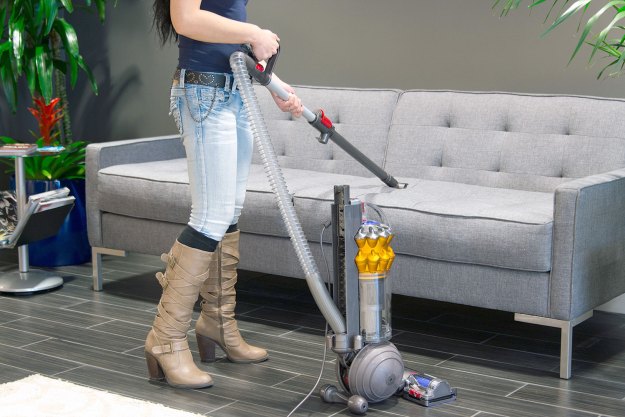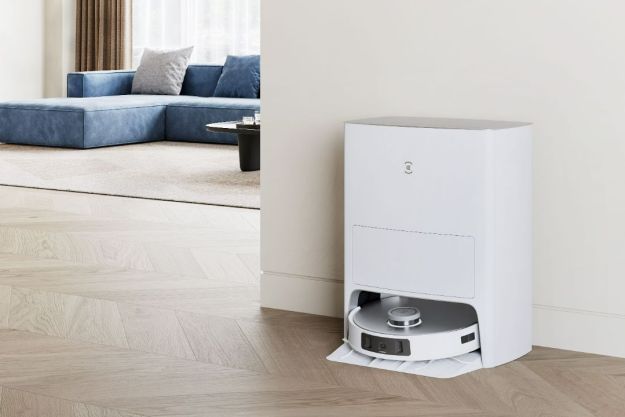
“This mighty mite brings the power of a Dyson to smaller spaces.”
- Works well on carpet
- Compact
- Easy to maneuver
- Works well on pet hair
- Difficult to carry
- Doesn’t work as well on hardwood floors
- Expensive
With its bright colors and small stature, it might be easy to mistake the Dyson Small Ball vacuum for a child’s toy. But no, the company says the compact machine is simply meant for smaller homes. It’s not the company’s first foray into a small vacuum, and the Small Ball has updates to several features from the very similar Dyson Ball Compact Animal. For $400, Dyson says you get an easy-to-store cleaner that handles both hardwood and carpeted flooring.
Here’s what I found when I tested it out.
Handling it
The Small Ball is 32 inches tall, with its handle collapsed. It has a familiar Dyson style, especially with the rest of the Ball models, though this one sports a gray-and-bronzish-yellow color scheme. The canister is clear, giving you an all-too-transparent view of how gross your floors are. The vacuum has two wheels in the back and a cleaner head with a nylon-bristle roller in front. Its bin has a capacity of 0.21 gallons, and it comes with two attachments: a combination tool with a brush on the end and a stair tool with velour strips for picking up hair.
The vacuum’s handle raises and retracts, based on whether you’re using it or storing it. It lifts when you pull it, but you have to press a large red button to get it to lower again. It clicks into place at only one height, about 10 inches tall — a size that seemed to work equally well for my 5-foot-3-inch mother and 6-foot-2-inch father when they gave it a spin. The hose tucks away into a compartment within the handle. To use the hose with the attachments, you have to completely unwind all 31 feet of the cord to get to it, which is annoying if you’re just spot cleaning with an attachment tool.
The same button on the handle unlocks the hose, so you can slide the handle backwards and pull it out. You can either pull the handle all the way out of the hose and click the attachments into place on the hose, or flip the handle upside down, open the cap at the top, and use the wand as an extender. There are two protrusions on either side of the vacuum for holding the attachments when you’re not using them.
At just over 12 pounds, the Dyson seemed a bit heavy for something so small. There’s a handle on front for carrying it, but I found myself trying to use the actual handle pick it up, only to have that pull up as though I was getting ready to start cleaning with the machine. Sometimes when I was moving the vacuum, I would accidentally hit a button, and the handle would detach and the whole thing would collapse in response.
The eponymous ball helps the vacuum maneuver pretty easily. It was good at fitting into tight corners. However, because it’s so bulbous, it did limit my ability to get the vacuum all the way under some folding chairs.
The vacuum is mostly plastic, and there are a lot of red buttons all over the place. There’s one for lowering the handle, one for detaching attachments from the hose, a slider button on the cleaner head for changing the suction from “powerful” to “max.” Even the power button is red. These are mostly easy to use, but I did sometimes have to try multiple times to release the hose from its compartment.
One upgrade Dyson made to the Compact Animal’s design for the Small Ball affects how the vacuum remains upright. To activate the cleaning head’s roller brush bar, the handle has to be at an angle, which happens when you tug the handle backwards with a bit of force. You push it back upwards to lock it upright, and Dyson says it has a new magnetic lock to help it stay in place. Dyson also says the new vac is 30-percent quieter than the Compact Animal.
Spreading the mess around
The Small Ball is made to work on both hardwood and carpet, but it has a special button that stops the roller brush from rotating. On earlier models, Dyson recommended flipping the switch for delicate flooring and rugs, but that’s not necessary with the Small Ball.
When I dumped cereal or rice on the floor (for testing, not just because I’m messy), the Dyson would sort of push a lot of the debris around the floor before eventually sucking it up. The vacuum picked up almost all 100 grams of our test messes, but for the cereal, it took almost two minutes to get everything in the canister. I had to pick up the vacuum so I didn’t shove everything into a corner under the counter. Its maneuverability actually helped here, making it a bit like a ballet, but I’d rather just have it clean everything up on the first pass. When I dragged the Dyson backwards through the flour, for example, it ended up blowing it around a bit. It definitely would’ve been faster to grab a broom. On carpet, however, it quickly suctioned up every mess I threw down, picking up nearly 100 percent of the debris.
This mighty mite brings the power of a Dyson to smaller spaces.
Though not specifically made for pet hair, the Small Ball performed well in our tests, both with the roller brush and the brush attachment. I didn’t even miss the specialty pet-hair tool, which the Compact Animal comes with.
It’s important to be able to clean your dust-filled dustbuster, and Dyson makes it fairly easy — though sometimes it feels like you’re lining up a codex to get everything situated properly to open things up. The bin comes out with the push of a button, and there’s another button that makes the bottom of the canister drop open, depositing debris in the trash. (Hopefully. Sometimes it swung open too vigorously, and I had a fresh mess on my floor.) The canister itself also comes apart, with the help of yet another button, so you can do a better job of cleaning out the nooks and crannies.
Conclusion
Despite its mini size, the Dyson Small Ball vacuum has a lot of the suction power of bigger machines. It can’t quite transition from carpet to hardwood as easily as I’d like; it definitely leaves some of the mess behind and is more laborious than simply sweeping up spilled Cheerios. At $400, the Dyson targets the crowd who live in swanky but small digs. But at 12 pounds and with a somewhat quirky handle setup, it’s not something you’d want to be lugging up and down stairs. It’s best for those single-floor penthouses.
Editors' Recommendations
- Best vacuum deals: Cordless to corded, Dyson to Bissell
- Best cordless vacuum deals: Big discounts on Dyson, Shark, and more
- Dyson’s new AR mobile app shows where you forgot to clean
- The 7 best vacuums for pet hair from Dyson, Shark, and more
- The best cordless vacuums for pet hair, wood, and more







